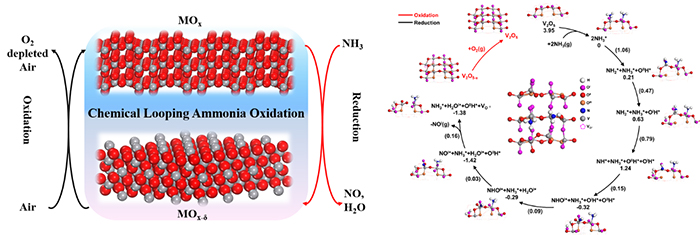Researchers Achieve Catalytic Ammonia Oxidation via Chemical Looping
Selective oxidation of ammonia to nitric oxide over platinum-group metal (PGM) alloy gauzes is the crucial step for nitric acid production, a century-old, and emission intensive process.
Therefore, it's important to develop alternative ammonia oxidation technologies with low environmental impacts and reduced catalyst cost.
Recently, a research group led by Prof. WANG Xiaodong from the Dalian Institute of Chemical Physics (DICP) of the Chinese Academy of Sciences (CAS), in collaboration with Prof. LI Fanxing from North Carolina State University, proposed and demonstrated an chemical looping ammonia oxidation catalyst and process to potentially replace the costly noble metal catalysts with reduced greenhouse gas emissions.
This study was published in Nature Communicationson Feb. 7.

Schematic of the chemical looping ammonia oxidation (CLAO) process and proposed reaction mechanism. (Image by RUAN Chongyan and WANG Xijun)
The researchers used a PGM-free V2O5 redox catalyst to achieve ammonia oxidation process. This new approach exhibited near complete NH3 conversion and exceptional NO selectivity at 650 °C, with negligible N2O production.
Operando spectroscopy techniques and density functional theory calculations pointed towards a modified, temporally separated Mars-van Krevelen mechanism featuring a reversible V5+/V4+ redox cycle.
The V=O sites were suggested to be the catalytically active center, leading to the formation of the oxidation products. Meanwhile, both V=O and doubly coordinated oxygen participate in the hydrogen transfer process.
The performance originated from the low activation energies for the successive hydrogen abstraction, facile NO formation as well as the easy regeneration of V=O species.
"Our study provides a potentially transformational process in extending the chemical looping strategy to producing base chemicals in a sustainable and cost-effective manner," said Prof. WANG.
This work was supported by the National Natural Science Foundation of China and the Strategic Priority Research Program of the Chinese Academy of Sciences. (Text by RUAN Chongyan)